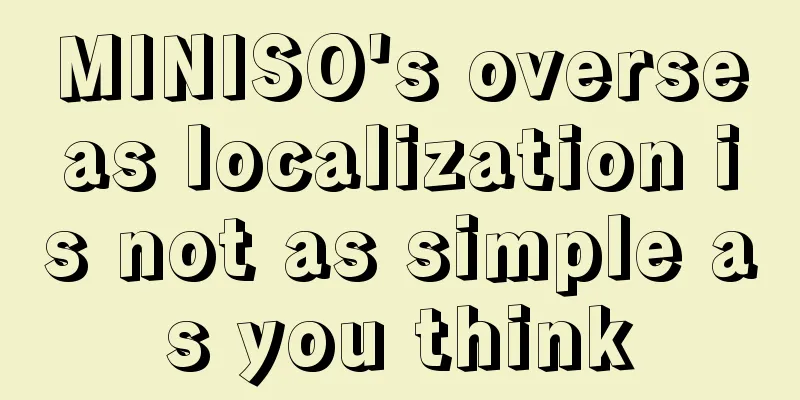MINISO's overseas localization is not as simple as you think

Last month, I was researching MINISO's overseas expansion, and by the end of the month, I happened to catch a breaking news: on June 22, MINISO opened a store on the Champs-Elysées in Paris, France. Not only is it a neighbor of the LV flagship store, but it is also just a few steps away from the Arc de Triomphe. This once again puts into practice Ye Guofu's philosophy: "To be a global brand, you must occupy the world's top business districts." Moreover, the flagship store on Champs-Elysées covers an area of 800 square meters, which is twice as large as the store that opened in New York's Times Square in May last year . The sales on the first day of opening also set a new record. "Singer 2024" was very popular a while ago - it was the variety show that created the popular meme of "a 50-year-old lady bravely guarding the national gate". The reason for "guarding the national gate" was that the director team invited a singer from the Grammy Awards, and netizens immediately joked that "there is no one in the domestic entertainment industry who can compete", and only Na Ying, who is over 50 years old, is barely holding on. The reason why Grammy singers and domestic singers gathered in Changsha to compete on the same stage is that both domestic entertainment and Grammy have discovered each other's cost-effectiveness: domestic entertainment has discovered that Grammy singers are actually cheaper than domestic singers, and Grammy singers have discovered that coming to China not only makes more money but also that their peers are not as good as them. I suddenly realized that this is somewhat similar to MINISO’s overseas expansion strategy: overseas markets discovered that Chinese products are good and cheap, and Chinese products discovered that overseas markets are more profitable and have almost no close competitors. Note that the "Chinese products" here refer to Brand in China , not simply Made in China . This is also the difference between "going overseas" and "exporting" . For the real economy, going overseas and exporting to other countries have in common the fact that they both sell domestic products overseas, that is, they realize overseas arbitrage of domestic supply chains . (It can be seen that China's supply chain is a long-established advantage, so the focus of this article is not on the supply chain issues of MINISO) The difference is that the goods exported by China overseas are basically sold under OEM , and the title of "World Factory" has long been known to everyone; while going overseas has only just begun to take off on a large scale . For example, the flagship store opened by MINISO in Times Square, New York, USA in 2023 broke the gap of zero Chinese brands in Times Square for the first time [1], becoming one of the milestone events for Chinese brands going overseas. After entering 2024, Miniso 's total revenue in the first quarter was 3.72 billion yuan, a year-on-year increase of 26%. Among them, overseas revenue was 1.22 billion yuan, a year-on-year increase of 53%, and gross profit margin increased to 43.4%. Net profit was 620 million yuan, a year-on-year increase of 28%. [2] Revenue, gross profit and net profit all hit record highs. MINISO does have an unquestionable record, but I am not exaggerating to praise it. After all, good-looking praise is all the same, but interesting disassembly is rare. So, do you want to know about MINISO?
These three questions correspond to the three strategic points of direct sales, localization, and physicality. Has MINISO really succeeded in these strategies? Behind the neon lights of New York's Times Square, what are the "unspeakable secrets" of MINISO? Wait, but what does all this have to do with Guo Degang? Don’t worry, read on. 1. From export to overseasThe opening of a flagship store in New York's Times Square last year was another major milestone for MINISO. Perhaps many people only started to pay attention to this brand at that time, but as early as 2015, when the company was founded two years ago, MINISO had already started its overseas expansion journey. It has been a full ten years today. In the past decade, MINISO has expanded to Southeast Asia, Oceania, Latin America, North America, and Europe, and has also been listed on the US stock market (2020) and the Hong Kong stock market (2022). We can see from the financial report that as of the first quarter of 2024, MINISO has a total of 6,630 stores worldwide, of which 2,596 are overseas stores, located in 107 countries and regions[2] , including developed countries such as the United Kingdom, France, the United States, and Canada, as well as developing countries such as the Philippines, Malaysia, Mexico, and India. It has been growing rapidly almost every year in the past ten years, so why did it only seem to become famous last year? 1. Replace franchise stores with directly-operated storesThe answer is that the change in business model has brought about an increase in brand power. From 2015 to 2022, thanks to the cost advantage created by China's supply chain, MINISO mainly used "agent + trade" to expand its overseas business, which was still essentially an export business . At the same time, MINISO began to seek to brand its retail business . The IP strategy , which was launched only one year later than the overseas strategy (2016), was one of the important means to establish its brand image. After 2020, the IP strategy received a very good response in the domestic market, and MINISO's brand power gradually increased. As a result, the export business also began to transform into brand overseas. After 2023, it officially entered the globalization strategy explosion period. We have observed that MINISO's overseas business model has undergone the following changes over the years: Initially, MINISO started in Asia. Because there are many Chinese people and their consumption habits are similar, they can directly copy the mature domestic franchise method, which is called the "MINISO partner model" . That is, set up a subsidiary in the local area and then open it to franchisees. The franchisees pay the money, and the rest of the operation is handed over to the headquarters. Later, MINISO expanded to more countries and regions, and widely adopted the "agent model" . Except for Asia, more than 80% of overseas stores worldwide have adopted this model. Unlike franchising, agents need to operate and expand stores by themselves, while MINISO can penetrate quickly with light assets. For example, in Mexico, MINISO cooperates with Grupo Sanborns, the largest local supermarket chain. In addition to providing funds, it also provides store and rent discounts through its department stores such as Sears and Sanborns. Later, in order to build brand power, MINISO began to expand its "direct sales model" overseas. According to the first quarter financial report of this year, among MINISO's 2,596 overseas stores, there are 281 direct sales stores, a year-on-year growth rate of 87.33%; and the number of third-party stores is 2,315, a year-on-year growth rate of 16.86% [2]. Direct sales stores made a significant contribution to the growth of revenue in the first quarter. Although MINISO’s overseas stores are mainly concentrated in Asia, its overseas directly-operated stores are mainly concentrated in the United States and Canada .[3] Here, we will take the North American market as an example to observe the transformation process.[4] In 2017, MINISO entered North America and opened stores in many cities in the United States and Canada. At that time, these stores were basically bought out by agents, and MINISO's headquarters hardly participated in management and operation, but was only responsible for supply. Due to the low communication efficiency of agents and slow policy implementation, MINISO decided to gradually take them back to direct operation starting in 2019. By the first half of 2021, the impact of the epidemic on offline business caused these dealers' stores to operate poorly. Taking this as an opportunity, the agency market accelerated its transformation into a direct sales market, and a new operations team was dispatched in 2022. As of today, 80 to 90 percent of the stores in the North American market are directly operated stores. The remaining small number of franchise stores are historical issues. Some old agents are unwilling to give up their agency, so MINISO continues to cooperate with them, but no longer opens new franchise channels. 2. Global replication of domestic successful modelsIn the first few years of opening stores around the world, MINISO chose the agency model without hesitation, because the agency model has very low risks. The headquarters only sells goods to agents, and the local market expenses and losses are borne by the agents. The headquarters will make a profit no matter what, it’s just a matter of how much profit it makes. Later, it switched to direct sales. On the one hand, the agent was having difficulties in operation and had to close the store, but the headquarters did not want to give up this market. On the other hand, it could use the path paved by the agent to further enhance its brand image and popularity in the local market. The direct sales method is based on successful experience that has been verified in the domestic market[5]: Super IP: In 2019, MINISO took advantage of the popularity of the Avengers series of movies to launch a series of Marvel co-branded products, which received excellent feedback from the market. Since then, "IP co-branding" has become an important means of growth. By the end of 2023, MINISO will have more than 80 head IPs, more than 300 IP categories of products, and a cumulative historical sales volume of more than 700 million pieces ; the number of customers who have bought MINISO IP co-branded products has reached hundreds of millions worldwide; compared with ordinary users, users who have purchased IP products can contribute 263% more per person and the average customer price is 176% higher. Currently, MINISO has cooperated with more than 100 leading IPs such as Disney, Sanrio, and Marvel, and has launched tens of thousands of IP-related SKUs. In the first quarter of 2024, IP product sales accounted for 26%, and the proportion of overseas IPs increased significantly year-on-year to more than 40%. [2] Super Category: Among more than 400 product categories, MINISO has locked in the super categories of "aromatherapy" and "blind boxes". Both can provide emotional value to consumers, belong to high-repurchase categories, and have their own active traffic. As of the end of 2023, MINISO's aromatherapy products have accumulated sales of 1.8 billion yuan, among which "fireless aromatherapy" has achieved the first place in national sales for three consecutive years. Superstore: Under the development model relying on franchisees, small stores of 100-200 square meters make the most money, while large stores will reduce operating efficiency. However, with the support of "super IP" and "super categories", MINISO's brand power has been enhanced. At this time, large flagship stores not only take on the function of selling goods, but also become the choice of consumers for socializing, dating, and checking in. Therefore, "super stores" have spawned super performance. Super Marketing: In today's "users are media" communication environment, MINISO's marketing also follows the DTC route, giving full play to the rich characteristics of products, stores, and IPs, and stimulating users to create content on social media through various mechanisms, stimulating a large amount of high-quality content exposure at a relatively low cost, so that users return to stores or other sales channels. Taking MINISO's private domain members as an example, MINISO has developed a large number of communities and KOC groups based on user interests and stickiness, created more than 4 million pieces of content, and brought more than 1.7 billion content exposures. This model has also promoted a large number of phenomenal sales products. Super Symbols: MINISO’s brand logo is a “WINK smiley face” pattern, which has been saturatedly used in store materials, product packaging, shopping bags, and even internal corporate management. It not only conveys the brand’s emotional value, but also reduces the communication cost between the brand and consumers. These five "super" methods require relatively large investments. It is definitely unrealistic to ask agents to copy them, so direct sales are the only way to achieve success. It can be predicted that MINISO's development trend in the next few years will continue to be to increase the intensity of direct sales. 2. The Success and Concerns of Overseas LocalizationEven if there is a definite methodology in China, it does not mean that it can be adapted to overseas arbitrage. It is inevitable that it will not be able to adapt to the local environment. MINISO has also suffered from this. Liu Xiaobin, vice president and chief marketing officer of MINISO Group, once told the media: “MINISO was originally a global brand, and there were mistakes such as shipping winter products to tropical countries or using Chinese weighing standards on American scales.”[6] Of course, these are some extreme mistakes. What we should see is that each overseas market has its own particularity. Only by giving up the fantasy of once and for all can we achieve multi-point blossoming. The information disclosed in the 2023 financial report also confirms this point. From pricing, to product selection, to strategy, MINISO is deepening its overseas localization. 1. “One way to tie a monkey”Guo Degang has a famous way of training his disciples: a different way of tying each monkey . This statement is also appropriate when it comes to overseas expansion strategies. We see that this is what MINISO is doing now. The main reasons are as follows (there are countless personalized reasons for each market segment). First is the business model. As we mentioned before, MINISO has undergone a strategic transformation from franchising to direct operation, but many markets have their own historical evolution and may not accept a unified transformation plan. For example, Indonesia, as MINISO’s second overseas expansion destination, has, after seven years of exploration, already had 90% local employees and good local operation capabilities, and is expected to reach a scale of 1,000 stores by 2024[7]. The entire Southeast Asian market, including Indonesia, is the most stable, largest, and most profitable of all MINISO's overseas markets. In addition, labor is relatively cheap, so the total cost of operating a large store or renovating a store is much lower than in other regions. Therefore, it is not a bad idea to continue the "MINISO partner model." For example, in Mexico, where the company was first established and has been doing well, it is not realistic to cancel the agency model. When the agency in a region sells well, it is difficult for MINISO to convert it into a direct sales company because the local merchants will not give up the agency rights, and MINISO cannot set up a subsidiary to take over. [4] Therefore, the North American market has completed the transformation from agency to direct sales, but the prerequisite is that the agents voluntarily withdraw. MINISO can make this move well, which can be regarded as a blessing in disguise. The second is market preference. Among the five strategies that have been successfully implemented in China, one is "super category". We have already mentioned that the most popular categories among domestic consumers are aromatherapy and blind boxes. So, when applying strategies in overseas markets, we must not just copy the answers. After exploration, MINISO found that this super category is slippers in Southeast Asia, perfume in India, pocket wipes in the Middle East, and dolls in Mexico... Or when the aging level in some regions is relatively high, the IP co-branded products that MINISO is proud of will completely fail. The same is true for "super marketing". The mainstream social platforms in China are Weibo, Douyin, and Xiaohongshu, while overseas they are Tiktok, WhatsApp, Facebook, and Instagram... Again, it’s the economic level. Let's take the North American market as an example. The retail environment in the United States is good. Currently, there are more than 100 stores, and the store expansion speed is also fast. In the past year, an average of more than ten new stores were opened every month. Miniso plans to open 3,000 stores in the United States by 2030. Such a plan actually reflects MINISO's confidence in the US market, including the high spending power of the people and the abundance of store locations. After all, China has only 5,000 stores for a population of 1.4 billion, while the US population is less than 400 million. Canada, which is adjacent to the United States, is not doing so well. Among all the overseas destinations of MINISO, it is one of the least ideal ones. Currently, it has 55 stores and plans to open 15 more by the end of this year. The GMV in 2023 is about RMB 280 million, and the target for this year is about RMB 460 million. [4] Finally, there are group values. When MINISO went overseas a few years ago, its core competitiveness has always been cost-effectiveness, especially when the global economy entered a downturn, low prices became particularly attractive. However, people in some European countries are not willing to pursue low prices blindly. When a product is unexpectedly cheap, they will consider whether it is environmentally friendly, whether it involves exploitation of labor, and whether there is malicious competition. The relatively affluent living standards have cultivated their consumption concept of pursuing brand effects more, and they are relatively insensitive to prices. 2. Strive for “low price” mentality and make money from “premium price”Since there are huge differences between markets, the prices of goods cannot be the same. MINISO’s overseas markets generally follow a pricing logic: if the headquarters’ shipping price is Y, the final price will be Y*shipping discount*price increase ratio*exchange rate, and then be tied to a unified price band; if the sales at this price are not ideal, it will be adjusted downwards to a certain extent based on the prices of competing products and the final gross profit. [4] The commodity department of each country subsidiary has the pricing power in that country, which is mainly reflected in the price increase ratio and the price reduction range . (1) Price increase ratio: used to ensure profit margin Different from the domestic impression of “cheap and easy to use”, MINISO has begun to move towards the “light luxury” route in overseas markets. Undoubtedly, these super flagship stores in Times Square, New York, Champs-Elysées, Paris, and Oxford Street, London have raised the profile of MINISO. Since they are located next to international brands such as Hermès, Tiffany, LV, and Prada, the prices must be commensurate with the location.[8] However, top-tier business districts are few and far between, and generally high prices still rely on multi-faceted competitiveness. MINISO's overseas competitors are diverse, usually including brand chain boutiques, ordinary stores, and large supermarkets. According to Growth Black Box Analysis, MINISO has the following four advantages: Rich product line: In general, the rich product line is a core competitive advantage of MINISO. Currently, there are more than 400 sub-categories in total, and the categories of a standard overseas store account for more than 70%, with more than 2,000 SKUs. Among overseas competitors, boutiques of the same size generally cannot have so many SKUs. Fast update speed: Miniso's requirement for updating non-IP products is to replace 15% to 20% of the store's SKUs every 30 to 45 days. In other words, if a store has 2,000+ SKUs, it needs to add 300+ SKUs every month, an average of 70-80 new SKUs per week. If we also take into account the IP series that are promoted every 1-2 months, the speed of new product introduction is unmatched by other competitors. Strong store experience: If we only look at the product functions and practicality, many of MINISO's products can be found in local supermarkets with better cost-effectiveness. However, the products in supermarkets often lack a sense of design, and consumers usually buy for the sake of buying. MINISO's products have a certain uniqueness (such as IP co-branded products). At the same time, the stores full of design sense also provide consumers with a place to hang out. With a strong sense of experience and more customer traffic, sales conversion will naturally occur. Fast response of supply chain: Overseas stores can feedback the market opportunities they observe locally to the headquarters, and the headquarters can quickly mobilize its powerful supply chain to develop similar products and supply them to overseas stores. For example, when a competitor was selling blind tablets in an overseas market, MINISO's overseas subsidiary asked the headquarters to help develop Sanrio-copyrighted blind tablets, which later achieved good sales results in overseas markets. In this way, MINISO has addressed market demands from all angles, gradually breaking away from the shackles of the so-called "low price advantage" and starting to earn money from brand premium. For example, in the Southeast Asian market, after excluding factors such as exchange rates, its prices are 20% higher than those in China, but sales are still hot and even out of stock. (2) Reduction range: used to maintain price advantage or adjust business conditions Taking blind boxes as an example, if an overseas subsidiary sets the price at 20.99 and the competing product is priced at 18.99, we will consider sacrificing gross profit appropriately and adjusting the price to 16.99. If there is a factor of clearing inventory, the price will be reduced to 12.99 or below. According to the Black Box Growth survey, the country’s current economic situation is not good, and consumers are extremely sensitive to prices. The sales of many products will drop precipitously as the unit price rises. The average unit price of blind boxes in the country in 2023 was 9.9, and about 60,000 to 70,000 pieces could be sold per month. However, after the price increase this year, the average price was 15, and the monthly sales fell to 20,000 to 30,000 pieces, almost halving [4]. This reflects to a certain extent that MINISO still needs to take the cost-effective route in some overseas markets, and it is not realistic to blindly increase the price increase ratio. 3. Localization difficulties and interest distribution trapsIf you want to do a good job of overseas localization, it is not enough to have a few advantages. The situations you need to face sometimes sound outrageous, but in fact they are very realistic and helpless. (1) Theft and damage Everyone has heard of “Free Shopping in North America”, right? Perhaps many people take this as a joke, but in the 2023 financial reports of US retailers, almost all merchants cited retail theft as the reason for the decline in gross profit margin , including but not limited to Walmart, Target, Lowe's, Dicks Sporting Goods and Foot Locker. The loss is nearly $100 billion a year! [9] Miniso, which has ventured into North America, is not immune to this. Since the thieves are likely to be armed, the stores will not ask the staff to act bravely or risk their lives, and calling the police is usually useless. It is said that an unlucky store of MINISO once lost up to RMB 1 million worth of goods just by "receiving" those people who came to the store with sacks to "go shopping" in four months. Unfortunately, the measures taken to deal with the “zero-yuan shopping” policy have resulted in higher costs for these overseas stores. [4] First, these regions dare not hold back inventory , because the more inventory they hold, the greater the risk of theft, so they have no choice but to reduce inventory and purchase more frequently, which results in some products being sold out frequently and untimely replenishment; Second, to make it more difficult for the "0 Yuan Purchase" players, locks are installed on the store shelves to lock each product, but this will affect normal operations, especially during peak hours when the store is crowded with people, and the clerks have to run around to unlock the shelves for people. Sometimes the action is too slow, and consumers can't wait and simply don't buy; Third, the problem of theft and loss leads to a large discrepancy between the data in the management system and the actual display in the store , which in turn affects budget management and replenishment decisions. At present, in order to correct the data, the number of fixed inventory counts in stores has to be increased, which increases labor costs. (2) Invisible game between headquarters and subsidiaries As we mentioned earlier, MINISO's overseas market has undergone a transformation from agency to direct sales. The overseas subsidiaries built later have continued the agency-like model to a certain extent, that is, ordering from the headquarters + independent operation . One big difference is that the main basis for agents to purchase goods from the headquarters is "what goods are selling well and what goods have high profit margins", while subsidiaries not only have to sell goods, but also have to undertake some non-sales tasks in the company's strategy. This results in subsidiaries sometimes being passive in ordering decisions. If the headquarters insists that the subsidiaries must order certain goods, the subsidiaries will have to order them . If these goods are unsalable locally, the subsidiaries will have to find ways to deal with them themselves, whether by discounts or combination sales, all at the expense of profit margins. Take the United States as an example. Since the flagship store opened in Times Square, New York, the United States has become the benchmark and focus of MINISO's overseas market. Therefore, the headquarters will specially develop products for the US market to achieve the purpose of establishing the brand image. However, the US subsidiary pays more attention to sales, so these products will bring pressure. [4] As a directly-operated subsidiary, the financial statements must eventually be consolidated, so why did this helpless situation arise? The problem lies in the organizational structure: the merchandise department of the headquarters is independently assessed for KPIs . As long as the products are sold to subsidiaries, the performance is considered closed. As for the sales of subsidiaries, they are not directly related to the merchandise department of the headquarters. The two parties may form an invisible relationship of competing for performance. Even if the sales department of the subsidiary company reports problems such as unsuitable goods or inappropriate prices, the voice of the merchandise department at the headquarters will be drowned out, making the subsidiary feel somewhat helpless. In the past year, the headquarters' shipping prices have been rising. In theory, as long as the subsidiaries order the same amount of goods as before, the headquarters can make more money. At the same time, the management also hopes to use higher gross profit margins to cover various losses and expenses, making the financial statements look better. As a result, it has become more difficult for subsidiaries in some regions to sell goods than before, which can be considered a kind of "unspeakable secret" . 3. Physical stores vs. e-commerce, who can go further overseas?At this point in time, MINISO's overseas expansion is unique in the physical retail industry. But we know that it is very likely that a brand will not be defeated by its direct competitors, but by species that come from across industries and categories. 1. Will Temu's overseas expansion hurt MINISO?Since 2022, when MINISO began to recover from the impact of the epidemic and continued to grow rapidly overseas, Pinduoduo's overseas version Temu has also been rising in the same momentum. According to Pinduoduo's financial report, its revenue in 2023 was 247.6 billion yuan, a year-on-year increase of 89.68%, and its consolidated net profit was 60 billion yuan, a year-on-year increase of 60.33%. [10] HSBC pointed out that Temu's revenue accounted for 23% of Pinduoduo Group's total revenue in 2023, and this figure is expected to rise to 43% in 2024 and exceed 50% in 2025, when Temu may become profitable. Even in developed markets in the United States, Europe and Asia, Temu is expected to gain 3-6% of the market share. [11] It seems that Pinduoduo's successful experience in China has been successfully replicated overseas, mainly because the trends in overseas markets are also timely. According to EMarketer, Temu is taking advantage of the fact that shoppers are no longer relying on a single online marketplace like Amazon, but are browsing multiple retail websites and comparing prices on deals using search engines like Google.[12] In April this year, Omnisend conducted an in-depth survey of 1,000 consumers and found that although Amazon is still far ahead, 34% of respondents shop on Temu at least once a month, surpassing the 29% of eBay, an e-commerce pioneer with nearly 30 years of history. [13] It should be noted that Pinduoduo has only been overseas for less than two years, and Temu’s sites have already covered many countries and regions in Asia, Europe, Africa, North America, Latin America, and Oceania. It is not an exaggeration to call it a “blitzkrieg”. [14] The essence of the "blitzkrieg" is the same as in China, that is, extremely low prices. According to the sampling statistics of Zhejiang Securities, in terms of clothing and shoes, the price of Temu's sampled items is more than 30% lower than Shein; in terms of home furnishings, the price of some Temu standard accessories is even more than half of that of Amazon. This is completely opposite to the choice of MINISO: whether MINISO switched to direct sales or vigorously developed IP, its goal was to build its brand and create a premium; in order to pursue low prices while providing convenience to merchants, Temu created a hosting and semi-hosting model (I will not elaborate here, readers who are not familiar with it can refer to relevant information). In the end, except for the low prices that were recognized by consumers, other aspects were questioned. We found some public information, including but not limited to [15]: Data from the Better Business Bureau in the United States showed that in a short period of time, more than 900 complaints and more than 700 user reviews were received about Temu, most of which involved product quality or shipping and delivery issues. The average user rating of the platform was 2.5 stars. The German Chamber of Industry and Commerce (DIHK) has publicly warned that Temu's cheap products will lead to "distorted competition", while the Consumer Center has also warned that "low prices may lead to a decline in product quality and safety." In Japan, it was labeled "suspicious" and "unreliable", in stark contrast to the Japanese market's high standards for exquisite goods and packaging. However, we cannot underestimate Temu's future just because of the doubts. After all, those domestic consumers who hated price cuts in the past few years finally were tempted by the low prices , otherwise Pinduoduo's market value would not have exceeded that of Alibaba. 2. Unshakable social valueAlthough the scale of MINISO cannot be directly compared with Pinduoduo, as an offline physical business, MINISO has its own unique scene advantages, which is a barrier that will never be replaced by e-commerce. In fact, entertainment options are very scarce in cities in some developed Western countries . Although you can go hiking, surfing, and camping on vacation, you can't take vacation every day. So the only short-term entertainment option is shopping. Shopping has many functions, including meeting friends, killing time, and taking a walk. MINISO provides consumers with a place to "go shopping", which is why it advocates opening large stores. A lot of consumption is accomplished through this kind of casual "shopping", especially for grocery items with some IP design. No one would regard them as a necessity and purchase them specifically, but it is easy to "impulse consumption". The logic of e-commerce is "search" . The premise of search is that there is already a purchasing demand or a purchasing goal. This makes it difficult to bring about consumption other than clear demand. Apart from stimulating consumers with low prices, it is difficult to exert efforts in other aspects . Of course, content e-commerce has also developed in the past two years. Tiktok uses fascinating content to arouse users' interest in certain products and can also lead to impulse purchases . But it still cannot meet the needs of a person's humanity - social interaction . After the epidemic, shopping malls have made a strong comeback, because the significance of such places is not only to sell goods, but also to provide a huge role for people to socialize. As long as there is social interaction, there will be customer flow, and with customer flow, there will naturally be consumption. You see, no matter which city’s tourist attractions you visit, you can see people selling stinky tofu. People don’t care whether this is Hunan or not, nor do they care whether the taste is authentic. As long as there are enough tourists, stinky tofu will sell well! MINISO might also think: I sell stinky tofu. Not only is the location good and the price affordable, but I also have co-branded flavors with various well-known IPs. It makes no sense that I shouldn’t be able to make money from this, right? IV. ConclusionThere are still more than 20 days until the opening of the Paris Olympics. According to statistics, the average monthly passenger flow of the Champs-Elysées in Paris exceeds 1 million. When tourists from all over the world come for the Olympics, the passenger flow of the Champs-Elysées is expected to continue to grow. And MINISO, taking advantage of the dual popularity of the Olympics and Champs-Elysées, is expected to achieve yet another peak in performance. Our analysis of MINISO's overseas expansion is certainly not completely thorough, but through our research and analysis, we hope to provide some information gaps and reference thinking to many brands that are exploring or about to expand overseas. References: [1] MINISO’s global flagship store opens in New York’s Times Square [2] MINISO Financial Report [3] MINISO, expensive and money-making abroad | Bad reviews [4] Channel research and expert interviews [5] 10,000-word interpretation: How did MINISO become a global super brand? | Gehui Strategy [6] How did MINISO become the “king of overseas expansion”? | New Retail Business Review [7] MINISO released its unaudited financial report for the first quarter of fiscal year 2024 and plans to open more stores overseas|Titanium Media [8] MINISO, known as the “offline Pinduoduo”, opened its overseas stores next to Hermès and Galeries Lafayette|Alpha Factory [9] Nearly $100 billion loss in one year! “Zero dollar shopping” hits US retailers’ financial reports hard | First Financial [10] Pinduoduo Financial Report [11] HSBC: Temu may achieve profitability in 2025, by which time Pinduoduo’s overseas revenue will account for more than half | Wall Street Journal [12] EMarketer [13] Omnisend Survey [14] Hugo Cross-Border [15] Pinduoduo Temu: The new darling of overseas markets, Amazon is “in crisis”! |Insight Research Report Source: WeChat official account: "Growthbox (ID: growthbox2)" |
<<: After 5 years as a sweet potato blogger, I have summarized 83 valuable experiences
>>: Car companies are developing side businesses and competing for customers across industries?
Recommend
How to open a cross-border e-commerce store? Pay attention to these points
As the domestic e-commerce industry is becoming in...
What is the best time to buy Amazon Lightning Deals? How long does it take for Amazon Lightning Deals to happen?
As one of the world's largest e-commerce platf...
No one can "wake up" Double 12
From shopping sprees and shopping festivals to goo...
Do you have your own workflow?
This article specifically introduces the methods a...
The BDZF model for e-commerce is used by the world's top 500 companies
This article abandons various "high-sounding&...
Why can Xiaohongshu buyers have low followers and high GMV?
Xiaohongshu buyers will become a new force in the ...
How to place Amazon video ads? What are the requirements?
Traffic is also very important for Amazon merchant...
Games + learning, the secret behind Duolingo's 97.6 million monthly active users
This article deeply analyzes how Duolingo has attr...
Unveiling Jingxi’s self-operated business: Creating a “Pinduoduo” within JD.com
In the territory of e-commerce giant JD.com, a new...
Can Amazon's 7-day promotion be canceled? What are the tips?
On Amazon, you can learn about the seven-day promo...
Is your labeling system empty and fake? These 3 tips can help you solve your business pain points
A good labeling system is essential for refined op...
How to ship large items on Shopee? What are the operation skills?
More and more merchants are opening stores on the ...
Which Shopee site is better? How to choose as a beginner?
Shopee's development in recent years is obviou...
How many products can Amazon's distribution model sell every day? Is Amazon's e-commerce reliable?
Selling products on Amazon is one of the important...
What kind of taxes do cross-border e-commerce businesses in Shenzhen need to pay? How are taxes calculated?
With the rapid development of China's cross-bo...









